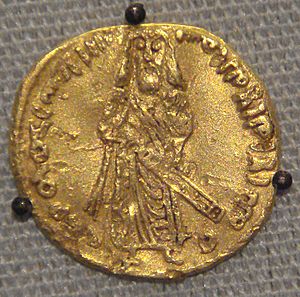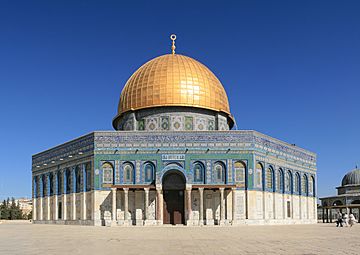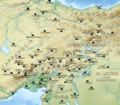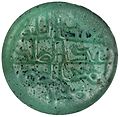Abd al-Malik ibn Marwan facts for kids
Quick facts for kids Abd al-Malik
عبد الملك |
|||||
|---|---|---|---|---|---|
|
|||||

Gold dinar minted by the Umayyads in 695, which likely depicts Abd al-Malik.
|
|||||
| 5th Caliph of the Umayyad Caliphate | |||||
| Reign | 12 April 685 – 9 October 705 | ||||
| Predecessor | Marwan I | ||||
| Successor | Al-Walid I | ||||
| Born | July/August 644 or June/July 647 Medina, Rashidun Caliphate |
||||
| Died | 9 October 705 (aged 58–61) Damascus, Umayyad Caliphate |
||||
| Burial | Outside of Bab al-Jabiya, Damascus | ||||
| Wives |
|
||||
| Issue | |||||
|
|||||
| House | Marwanid | ||||
| Dynasty | Umayyad | ||||
| Father | Marwān | ||||
| Mother | ʿĀʾisha bint Muʿāwiya ibn al-Mughīra | ||||
| Religion | Islam | ||||
Abd al-Malik ibn Marwan (born July/August 644 or June/July 647 – died October 9, 705) was the fifth Caliph of the Umayyad Caliphate. He ruled from April 685 until his death in 705. Abd al-Malik was one of the first Muslims born into the faith. He spent his early life in Medina, a holy city in Islam, focusing on religious studies.
Before becoming caliph, he held important jobs in the government and military. He served under Caliph Mu'awiya I, who started the Umayyad Caliphate, and his own father, Caliph Marwan I. When Abd al-Malik became caliph, the Umayyad government was in trouble. A big civil war, called the Second Muslim Civil War, had weakened their power. His father had managed to bring back control only in Syria and Egypt.
Abd al-Malik worked hard to reunite the Caliphate. He first secured Syria, then fought against his main rival, Abd Allah ibn al-Zubayr, who was based in Mecca. Abd al-Malik's general, al-Hajjaj ibn Yusuf, defeated Ibn al-Zubayr in 692. This victory brought the entire Caliphate back under Abd al-Malik's rule. He also expanded the empire's borders, taking lands in Anatolia, Armenia, and North Africa. His rule was a time of peace and growth for the Umayyad Caliphate.
Abd al-Malik made big changes to how the empire was run. He made the government more centralized, meaning more power was held by the caliph in Damascus. He introduced a new Islamic currency and made Arabic the official language for government records. These changes helped make the Umayyad state stronger and more distinctly Islamic. He also ordered the building of the Dome of the Rock in Jerusalem, an important religious monument. His strong leadership set the stage for his son, al-Walid I, to lead the Caliphate to its greatest size and wealth.
Contents
Early Life and Rise to Power
Abd al-Malik was born in Medina in western Arabia. This was either in July/August 644 or June/July 647. His family, the Banu Umayya, was a powerful and rich clan from the Quraysh tribe. The Quraysh tribe eventually became very important in Muslim politics.
Abd al-Malik was part of the first generation of Muslims born into the faith. He grew up in Medina, which was the center of Islamic politics at the time. He was known for being very religious and may have even memorized the Qur'an.
When he was young, Abd al-Malik saw the assassination of Caliph Uthman in 656. This event deeply affected him. Later, he served in the navy against the Byzantine Empire. Caliph Mu'awiya I appointed him to this role. He also worked as a secretary for his father, Marwan I, who was the governor of Medina.
In 683, a revolt broke out in Medina against Caliph Yazid I. Abd al-Malik and other Umayyads were forced to leave the city. This revolt was part of a larger conflict known as the Second Muslim Civil War. After Yazid I died, the Umayyad government faced a crisis. Many provinces chose to support Abd Allah ibn al-Zubayr, a rival caliph in Mecca.
Abd al-Malik's father, Marwan, became caliph in 684. He was chosen by pro-Umayyad tribes in Syria. Marwan relied heavily on the Yamani tribes. This led to a long-lasting rivalry with the Qaysi tribes. Abd al-Malik became a close advisor to his father. He was appointed governor of Palestine and chosen as Marwan's successor. When Marwan died in April 685, Abd al-Malik became the new caliph peacefully.
Challenges and Victories
When Abd al-Malik became caliph, he faced many problems. Most parts of the Caliphate still supported his rival, Ibn al-Zubayr. Also, the Qaysi tribes were rebelling in northern Syria.
Reuniting the Caliphate
Abd al-Malik's main goal was to bring the entire Caliphate back under Umayyad control. He first focused on reconquering Iraq, which was a very rich province. His general, Ubayd Allah ibn Ziyad, led an army into Iraq. However, this army was defeated in 686, and Ibn Ziyad was killed. This was a big setback for Abd al-Malik.
After this defeat, Abd al-Malik focused on making Syria secure. He made a peace treaty with the Byzantine Empire in 689. This treaty was not very favorable to the Umayyads, but it bought him time. He also put down a coup attempt in Damascus by his cousin, Al-Ashdaq. In 691, he brought the rebellious Qaysi tribes back into his army. This greatly strengthened the Syrian army.
With Syria secure, Abd al-Malik again turned his attention to Iraq. He led the Syrian army himself and defeated Mus'ab ibn al-Zubayr, Ibn al-Zubayr's brother, in 691. After this victory, he sent his skilled general, al-Hajjaj ibn Yusuf, to Mecca. In 692, al-Hajjaj besieged Ibn al-Zubayr in Mecca. The Kaaba, a holy site, was even bombarded during the siege. Ibn al-Zubayr was killed, ending the civil war. This reunited the Caliphate under Abd al-Malik's rule.
Expanding the Empire
After reuniting the Caliphate, Abd al-Malik resumed the war with the Byzantines. His forces won a major battle in 692. Over the next few years, Umayyad armies launched many raids into Byzantine lands. His brother, Muhammad, and his sons, al-Walid, Abd Allah, and Maslama, led these campaigns. These actions prepared the way for more conquests by his successors.
In North Africa, the Umayyads had lost control of Ifriqiya. In 695, Abd al-Malik sent a large army led by Hassan ibn al-Nu'man to retake the region. Hassan captured and destroyed Carthage in 698. This marked the end of Byzantine power in North Africa. He also secured Kairouan as a base for future conquests. Abd al-Malik ordered the building of a new port city, Tunis, to create a strong Arab navy. Hassan continued fighting the Berbers and defeated their leader, al-Kahina. Later, Musa ibn Nusayr took over and led the conquests of western North Africa and the Iberian Peninsula.
Controlling the East
Controlling Iraq and the eastern provinces was still a challenge. Abd al-Malik appointed al-Hajjaj as governor of Iraq in 694. Al-Hajjaj was a very effective and strict ruler. He put down revolts by the Kharijites, a group of rebels. By 698, these revolts were crushed.
Al-Hajjaj also faced a major rebellion led by Ibn al-Ash'ath. This revolt involved many Iraqi tribal leaders. Abd al-Malik sent Syrian troops to help al-Hajjaj. The rebellion was finally defeated in 702. This victory meant that Syrian troops became the main military force in Iraq. Al-Hajjaj built a new city, Wasit, as a permanent Syrian military base. This helped the caliph keep strong control over Iraq.
Key Reforms and Legacy
Abd al-Malik's final years were peaceful and prosperous. He successfully managed the rivalries between the Qays and Yaman tribes. He also made sure his eldest son, al-Walid, would succeed him. Abd al-Malik died on October 9, 705, and was buried in Damascus.
A Stronger Government
Abd al-Malik is seen as one of the most important Umayyad caliphs. He transformed the Caliphate into a more centralized empire. He put an end to provinces keeping most of their tax money. Instead, these funds were sent to the caliph's treasury in Damascus. He also made sure that only those actively serving in the military received salaries. This was a big change from earlier times when veterans and their families received payments.
He also improved the postal service, which helped him stay informed about events across the empire. He built and repaired roads, especially connecting Damascus with Palestine and Jerusalem. This was part of his plan to centralize power and show Jerusalem's importance.
New Currency and Language
One of Abd al-Malik's most important changes was creating a new Islamic currency. He stopped using Byzantine gold coins, especially after the Byzantines put an image of Christ on their coins. In 693, he introduced the gold dinar, a new Islamic gold coin. These coins first showed the caliph, but later were changed to only have religious inscriptions from the Qur'an. Similar changes were made to silver coins in the eastern parts of the empire.
Around 700, Abd al-Malik made Arabic the official language for government records in Syria. Al-Hajjaj had already started this process in Iraq. This meant that Greek and Persian were replaced. This change helped unify the diverse tax systems and made the government more distinctly Muslim. It was a big step in making Arabic the main language of the Umayyad state.
Reorganizing the Army
Abd al-Malik changed the army from a collection of tribal groups to a more organized force. He relied more on loyal Syrian troops. After the Iraqi rebellion, Syrian soldiers were sent to keep order in the provinces. This made the Syrian army the main military power in the Caliphate. This professional army was paid directly from the government's taxes.
Building the Dome of the Rock
In 685/86 or 688, Abd al-Malik began building the Dome of the Rock in Jerusalem. It was finished in 691/92. This is the earliest known religious building constructed by a Muslim ruler. Its inscriptions are the first to clearly declare Islam and mention the Prophet Muhammad. The Dome of the Rock is a very important and unique Islamic monument.
Historians have different ideas about why Abd al-Malik built the Dome of the Rock. At the time, he was fighting the Byzantines and his rival, Ibn al-Zubayr, who controlled Mecca.
- One idea is that he wanted it to be a symbol of Islam's victory over Christians. It would show Islam's unique place among the older religions in Jerusalem, like Judaism and Christianity.
- Another idea is that he built it to draw attention away from Mecca. Ibn al-Zubayr used the annual pilgrimage to Mecca to speak against the Umayyads. However, many historians believe this idea is likely propaganda against Abd al-Malik.
- A third idea is that the Dome of the Rock was built to be a grand declaration of faith. It was meant to show Muhammad's role on the Day of Judgment.
Abd al-Malik's building projects were mostly in Jerusalem. Besides the Dome of the Rock, he is also credited with building the nearby Dome of the Chain. He also expanded the Temple Mount area to include the Foundation Stone.
Family and Homes
Abd al-Malik had many children with his wives and concubines. His sons al-Walid, Sulayman, Yazid II, and Hisham all became caliphs after him. This is why he is sometimes called the "father of kings."
He spent his time between Damascus and other homes nearby. He would spend winters in Damascus and Sinnabra. In the summer, he would go to Baalbek to escape the heat. His main home in Damascus was the Khadra Palace.
| Abbreviated family tree of Abd al-Malik | ||||||||||||||||||||||||||||||||||||||||||||||||||||||||||||||||||||||||||||||||||||||||||||||||||||||||||||||||||||||||||||||||||||||||||||||||||||||||||||||||||||||||||||||||||||||||||||||||||||||||||||||||||||||||||||||||||||||||||||||||||||||||||||||||||||||||||||||||||||||||||||||||||||||||||||||||||||||||||||||||||||||||||||||||||||||||||||||||||||||||||||||||||||||||||||||||||||||||||||||||||||||||||||||||||||||||||||||||||||||||||||||||||||||||||||||||||||||||||||||||||||||||||||||||||||||||||||||||||||||||||||||||||||||||||||||||||||||||||||||||||||||||||||||||||||||||||||||||||||||||
|---|---|---|---|---|---|---|---|---|---|---|---|---|---|---|---|---|---|---|---|---|---|---|---|---|---|---|---|---|---|---|---|---|---|---|---|---|---|---|---|---|---|---|---|---|---|---|---|---|---|---|---|---|---|---|---|---|---|---|---|---|---|---|---|---|---|---|---|---|---|---|---|---|---|---|---|---|---|---|---|---|---|---|---|---|---|---|---|---|---|---|---|---|---|---|---|---|---|---|---|---|---|---|---|---|---|---|---|---|---|---|---|---|---|---|---|---|---|---|---|---|---|---|---|---|---|---|---|---|---|---|---|---|---|---|---|---|---|---|---|---|---|---|---|---|---|---|---|---|---|---|---|---|---|---|---|---|---|---|---|---|---|---|---|---|---|---|---|---|---|---|---|---|---|---|---|---|---|---|---|---|---|---|---|---|---|---|---|---|---|---|---|---|---|---|---|---|---|---|---|---|---|---|---|---|---|---|---|---|---|---|---|---|---|---|---|---|---|---|---|---|---|---|---|---|---|---|---|---|---|---|---|---|---|---|---|---|---|---|---|---|---|---|---|---|---|---|---|---|---|---|---|---|---|---|---|---|---|---|---|---|---|---|---|---|---|---|---|---|---|---|---|---|---|---|---|---|---|---|---|---|---|---|---|---|---|---|---|---|---|---|---|---|---|---|---|---|---|---|---|---|---|---|---|---|---|---|---|---|---|---|---|---|---|---|---|---|---|---|---|---|---|---|---|---|---|---|---|---|---|---|---|---|---|---|---|---|---|---|---|---|---|---|---|---|---|---|---|---|---|---|---|---|---|---|---|---|---|---|---|---|---|---|---|---|---|---|---|---|---|---|---|---|---|---|---|---|---|---|---|---|---|---|---|---|---|---|---|---|---|---|---|---|---|---|---|---|---|---|---|---|---|---|---|---|---|---|---|---|---|---|---|---|---|---|---|---|---|---|---|---|---|---|---|---|---|---|---|---|---|---|---|---|---|---|---|---|---|---|---|---|---|---|---|---|---|---|---|---|---|---|---|---|---|---|---|---|---|---|---|---|---|---|---|---|---|---|---|---|---|---|---|---|---|---|---|---|---|---|---|---|---|---|---|---|---|---|---|---|---|---|---|---|---|---|---|---|---|---|---|---|---|---|---|---|---|---|---|---|---|---|---|---|---|---|---|---|---|---|---|---|---|---|---|---|---|---|---|---|---|---|---|---|---|---|---|---|---|---|---|---|---|---|---|---|---|---|---|---|---|---|---|---|---|---|---|---|---|---|---|---|---|---|---|---|---|---|---|---|---|---|---|---|---|---|---|---|---|---|---|---|---|---|---|---|---|---|---|---|---|---|---|---|---|---|---|---|---|---|---|---|
Abd al-Malik Marwanid caliphs Sufyanid caliphs Caliph Uthman |
||||||||||||||||||||||||||||||||||||||||||||||||||||||||||||||||||||||||||||||||||||||||||||||||||||||||||||||||||||||||||||||||||||||||||||||||||||||||||||||||||||||||||||||||||||||||||||||||||||||||||||||||||||||||||||||||||||||||||||||||||||||||||||||||||||||||||||||||||||||||||||||||||||||||||||||||||||||||||||||||||||||||||||||||||||||||||||||||||||||||||||||||||||||||||||||||||||||||||||||||||||||||||||||||||||||||||||||||||||||||||||||||||||||||||||||||||||||||||||||||||||||||||||||||||||||||||||||||||||||||||||||||||||||||||||||||||||||||||||||||||||||||||||||||||||||||||||||||||||||||
Images for kids
-
Map of the political situation in the Caliphate during the Second Muslim Civil War about 686. The area shaded in red represents the approximate territory controlled by Abd al-Malik, while the areas shaded in green and blue represent the territories of his respective rivals, al-Mukhtar and Abd Allah ibn al-Zubayr. The areas shaded in yellow represent territory controlled by the Kharijites
-
A milestone, found at Khan al-Hathrura near Jericho, produced on Abd al-Malik's orders on the road between Damascus and Jerusalem
-
A gold dinar of Abd al-Malik minted in Damascus in 697/98. Abd al-Malik introduced an independent Islamic currency in 693, which initially bore depictions of the caliph before being abandoned for coins solely containing inscriptions
See also
 In Spanish: Abd al-Málik para niños
In Spanish: Abd al-Málik para niños











